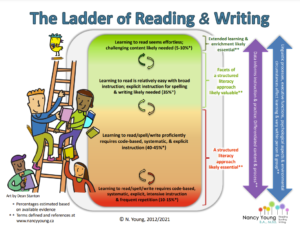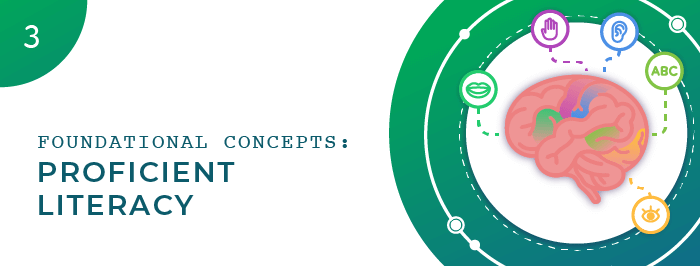Foundational Concepts: Proficient Literacy
Written by Sandie Barrie Blackley, Speech-Language Pathologist
Published on April 27, 2022
Dyslexic Students Can Become Proficient Readers and Writers
In our recent series on the building blocks for language and literacy, we looked at two foundational elements to proficient literacy:
- Comprehensible spoken input – language comprehension begins with spoken conversations in meaningful contexts
- Comprehensible written input – literacy emerges using the alphabet (letters) to represent words and meaning
For students on the dyslexia spectrum, fluency with written input is not automatic.
How Dyslexia Disrupts Proficient Literacy
The Simple View of Reading is a now universally accepted model in reading science. According to the Simple View, learning to read has two essential components:
- understanding spoken language (listening comprehension)
- understanding the printed word (decoding and spelling)
Children with dyslexia have a relative strength in spoken input and a relative weakness in written input. Sentences and paragraphs that would be easy to comprehend in spoken form become an exhausting challenge in written form.
Furthermore, these two “sides” of the Simple View formula have a multiplying effect when it comes to reading comprehension. For example, say a child is a 10 in listening comprehension but a 0 in decoding. If we multiply the two numbers, we can predict their reading comprehension will be 0. In other words, strength in one component cannot completely make up for weakness in the other.
Both components are essential for proficient literacy. Successful interventions must focus on giving each struggling reader the instruction and practice they need, matched to their pattern of strengths and weaknesses.
Overcoming Dyslexia
There are three essentials for overcoming dyslexia:
- A structured literacy curriculum, delivered consistently as directed
- A teacher or therapist who is an expert in the structure of the language
- Daily or near-daily deliberate practice
How Structured Literacy Can Help
“Structured literacy is a science-backed, comprehensive approach to teaching reading, writing, and spelling that is widely accepted as the world’s most effective way to teach literacy and to help struggling readers and writers.” This approach explicitly teaches decoding and systematic word identification strategies, which help most students and are essential for those with dyslexia. Structured literacy includes the production and analysis of language at every level, such as patterns and conventions of the writing system, sounds, spellings for syllables and sounds, and meaningful parts of words, sentences, paragraphs, and longer texts.

A structured literacy approach is critical for dyslexics. But the same three essentials required to overcome dyslexia can benefit all students to some degree. Nancy Young’s wonderful infographic, “The Ladder of Reading,” illustrates the value of a structured literacy approach: students who are not dyslexic may not need as much direct instruction and practice to achieve proficiency, but all students can gain fluency and improve their literacy through this approach.
Struggling readers, and especially students with dyslexia, need to be taught to recognize individual speech sounds. But so do all readers when it comes to some words. It is only through explicit instruction and practice that readers and writers learn to discern the difference between (for example) to / too / two …or… their / there / they’re …or… boys / boy’s / boys’ …or… how to approach an unfamiliar written word, working out its pronunciation and meaning.
What’s Next for Your Struggling Reader
Lexercise clinical educators are experts in structured literacy. The approach is individualized to each child. It includes a print-to-speech (reading) and a speech-to-print (spelling) structured literacy curriculum plus a program of daily practice that is engaging, instructive, and builds awareness and memory. In the first eight weeks of using Lexercise with a qualified Lexercise therapist, most students improve their reading proficiency by one full grade level.
To learn more, explore our dyslexia treatment pages online or contact us to discuss your child’s specific needs.
______
Additional Resources
To see Nancy Young’s infographic and links to supporting research, click here. This infographic was updated in 2021, see what was updated here.
Improve Your Child’s Reading
Learn more about Lexercise today.
Schedule a FREE
15-minute consultation



